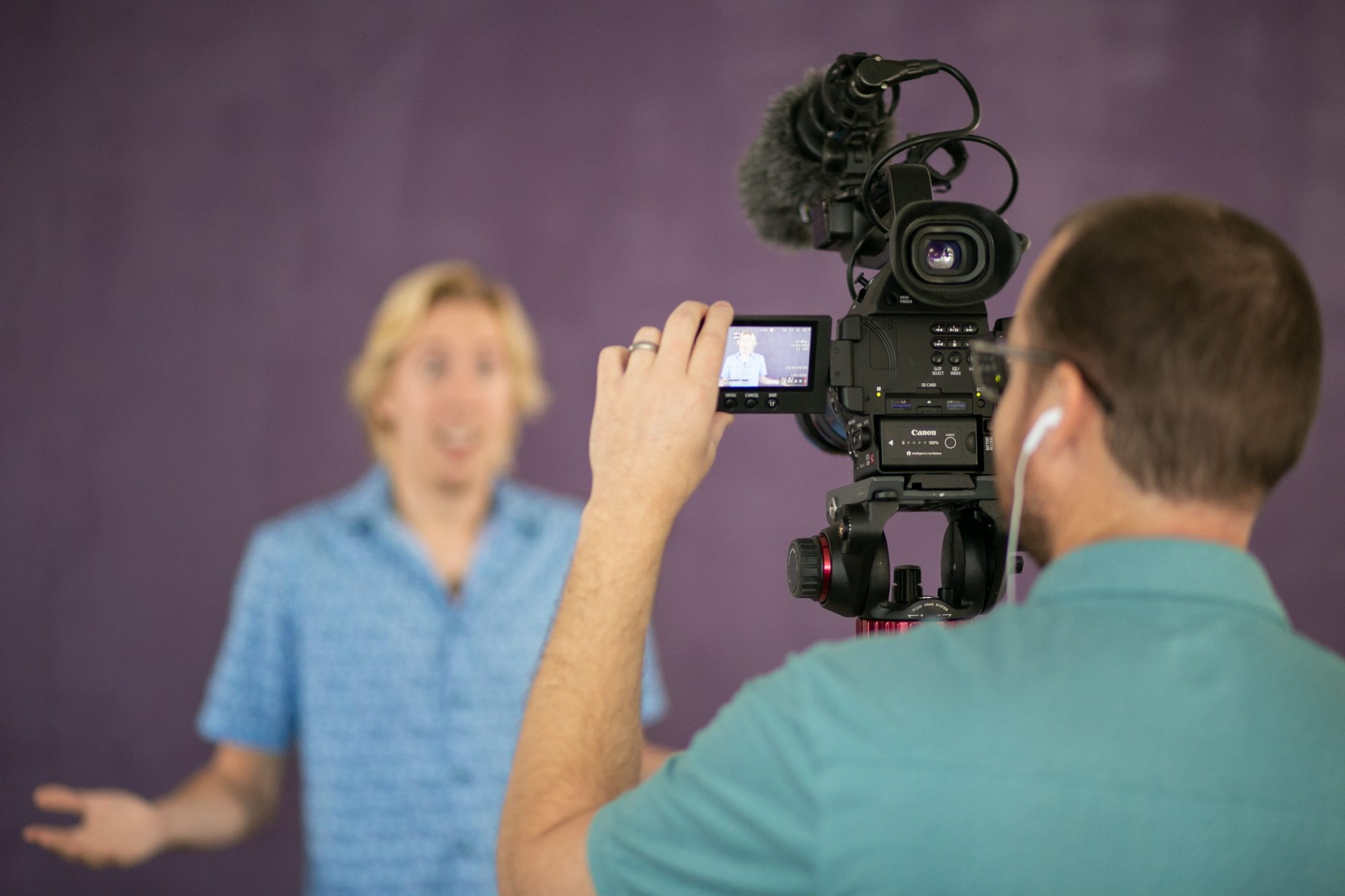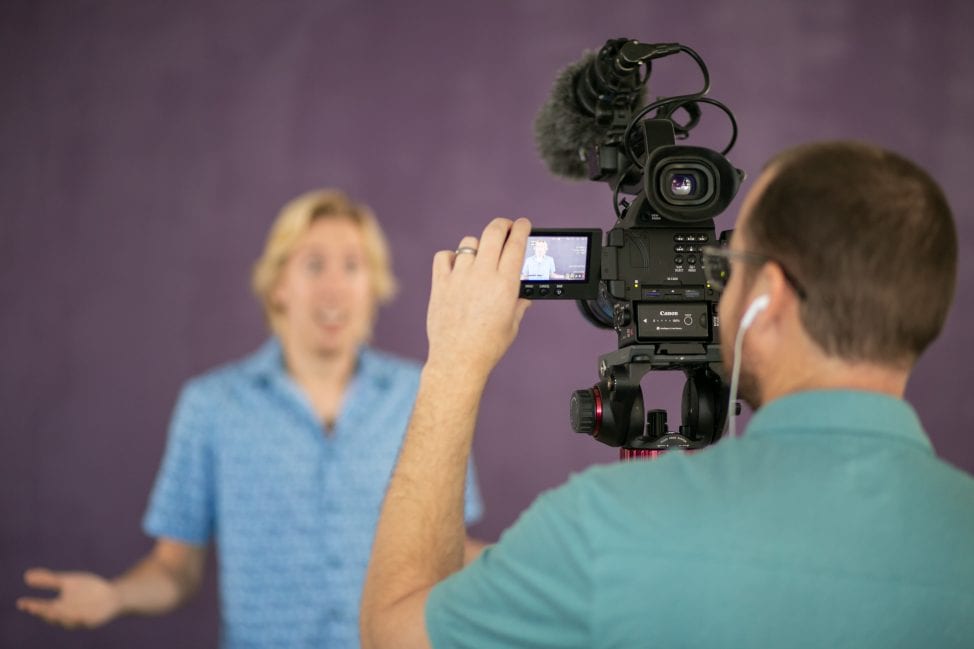Terrified of video? Here are our 8 best tips for feeling more comfortable in front of the camera.

Part of the fear of stepping in front of the camera comes from the uncertainty of it all.
First, we worry about how we look and sound on camera.
Then we worry about what to say, from scripting to presentation skills.
Once the shoot is finished, we continue to worry about all the things we forgot to say.
And even once the video is done, we worry about the best way to post and market the video.
When does it end?!
Here’s the secret: The stress ends once you finish your first video – because once your first video is said and done, you’ll realize you worried for nothing.
You’ll see the positive feedback on social media. You’ll get compliments at events. And you’ll even start to hear from prospective customers.
And you’ll look back and think: What was I so worried about?
To save you from that needless stress cycle, we compiled a list of 8 tips to help you feel more comfortable in front of the camera — and finally create your first marketing video!
How To Feel Comfortable In Front Of The Camera
1. Know your why.
First and foremost, it’s crucial to understand why you’re doing video if you want to feel comfortable in front of the camera. Especially if you’re nervous, the resistance will be so much stronger if you don’t understand why you’re doing this.
Conversely, if you’re clear on the purpose of your video marketing, then you’ll be more focused on the goal and less in your head. The fears of how you will look or sound on camera will seem smaller compared to the goal you’re trying to achieve. Whether you’re nervous or not, you’ll understand why you’re putting in the time and work to create marketing videos for your brand.
This is a crucial first step for all video marketing projects, regardless of whether you’re camera-shy or you were born for the stage.
2. Commit to consistent practice.
The best way to feel more comfortable in front of the camera is to jump in front of it – and regularly. The more you give yourself consistent opportunities to practice, the more quickly you’ll move through the fear and into a place of confidence. We always tell people this, and sometimes they do it; sometimes they don’t. But when they do, it makes a significant and recognizable difference.
Like anything else, video requires commitment. By signing up for a video subscription – where you film new videos each month – you’re committing to that practice in a professional way. Hiring a video team and working with other professionals acts as a positive motivator for you to show up fully and take the process seriously. You won’t give into your fears as easily if your friend or peer is behind the camera.
Our Custom Video Subscription is ideal for professionals who want to learn in the most comfortable setting possible and move at their own pace — because with this subscription, you control the show. You decide the set location, video length and style. We’ll do as many takes as you need to get it perfect, and we’ll coach you on everything from posture to speaking skills and messaging. Find out more about our SchlickArt Custom Video Subscription here.
Practice, practice, practice!
3. Prepare in your own way.
Everyone prepares for video in a different way. While writing out a word-for-word script might work for one person, that might overwhelm and fluster the next person. The key here is to figure out which method of preparation works for you.
If you do best when you’re speaking off the cuff, that’s great. But that doesn’t mean you should skip the preparation process. Spend the time to understand your why, or set parameters for how in-depth you’ll go into your topic – that way, you won’t overwhelm your point. Write out your call to action, so you know how to get your audience to take the next step in your sales pipeline.
We often suggest writing out your ideas on paper, even if that means just jotting down a few notes in bullet-point form. It helps you get your thoughts out of your head, and allows you to sort through them in an organized way. The process of writing it out helps you focus your point and feel more prepared once the camera is one you.
The bottom line is you need to feel prepared if you’re going to kick the nerves and get over your fear of video. So the important thing is to prepare in a way that makes you feel confident.
4. Look the part.
For most people, the fear is based on worrying about how you look and sound on camera. By making an effort to dress the part, you’ll feel more confident in your own skin – and on camera. Simply put: It’s one of the easiest ways to increase that sense of confidence.
To dress the part, choose an outfit that makes you feel comfortable and confident yet also matches your brand. At first, you may even want to overdress a bit just to make sure you feel your best.
Ladies, wear your hair and makeup the way you normally do when you see your clients, but add a little more foundation than normal. Think of a “night look” versus a “day look.”
For men, the general rules are the same. Dress the way you would when you see your clients or go to a big meeting. Stay away from any wardrobe or grooming choices that would make you look drastically different from your day-to-day look. The goal is to be confident but recognizable.
At SchlickArt, we always pause to check your appearance, and with a photographer’s eye, nothing gets past us. If a hair is out of place, or your necklace isn’t hanging straight, we’ll catch it. But if you don’t have a professional on set to check you, ask a friend to come take a look and be your back-up.
5. Don’t rush it.
Now, once you’ve gone through the steps to prepare before the shoot starts, it’s time to prepare your mindset for when you actually hit record.
The most important thing you can do to calm down on the day of the shoot is simply breathe. Take a breath before you begin your first word. Take a breath when you mess up. Take a breath when you feel like you’re speaking too quickly.
A long, slow, conscious breath will always reset you and bring you back to a place of calm, cool connectedness that will absolutely show up on camera.
Once you start, don’t forget to keep breathing. Don’t rush through it or power through it. Make sure you’re moving at a steady pace. Talk like you would to a friend; don’t rush through it like you hate being there.
If you own your space and take your time, you come across more confidently, and people will want to hear what you have to say. So take a breath, and slow down.
6. Expect mistakes.
While we’ve had clients wow us with a perfect take on the first try, you don’t want to create that expectation for yourself if you’re nervous. In fact, if you tell yourself to expect a mistake or two, then you take the pressure off – and you increase the chance that you’ll actually ace your first take. But going into it with the hope that you’ll be absolutely perfect is not going to help calm your nerves.
Plus, it’s important to remember that you can always take a second shot, and there will always be more opportunities to be on video and grow your presentation skills. You don’t need to be perfect the first time, the second time or the third. You have as many takes as you need to get it right, and every time you hop in front of the camera, it will get easier. So don’t pressure yourself by making perfection the expectation. It will likely backfire. And progress is more than good enough anyway.
7. Schedule it.
Once you’ve gotten past your first video, you’re not done. Remember, the only way to truly overcome that fear is to simply get in front of the camera as often as you can. And the best way to do that is to schedule time for video in your calendar. If you don’t set aside time for future video practice, you won’t do it. Simple as that.
But if you treat it like any other business task or to-do on your list, then you’re more likely to make real, lasting progress. So schedule regular time for video, and you’ll absolutely see progress with each attempt.
8. It’s bigger than you.
Last but not least, if you still can’t get past the fear, remember this: It’s bigger than you.
If you’re a business owner, video marketing isn’t about looking good or having perfect on-camera skills. It’s about staying relevant as the entire market moves online. Video is not going away. It’s only becoming a more popular form of marketing for consumers and marketers alike.
It’s important to remember video marketing is about sharing your value with the people who matter most: your clients. It’s about making a difference with the value and information you have to share. And at the end of the day, it’s the most effective and compelling form of marketing that exists right now.
Don’t you want that for your business? Isn’t that more important than having a bad hair day on camera? Isn’t it worth it to get over your fear of video?
Bottom Line
We can help you get over your fear of video.
We know how hard it is to step in front of that camera. In fact, we get nervous ourselves! That’s why every video product we offer is designed to help you feel more comfortable in front of the camera. We create a safe, fun environment for you to get over your fear of video, and then we walk you through it one step at a time.
About Our Quality Video Marketing in Santa Clarita
With years of professional experience, Brian not only has an eye for crisp visuals and engaging shots — but also an ear for powerful storytelling. In his vision, marketing video should communicate the why behind your business and present it to the world in the most compelling visual format possible. With a camera in his hand, Brian can turn a vision into reality and business-as-usual marketing videos into an opportunity to connect.
About Brian Schlick
Starting as an onboard Princess Cruises videographer, Brian quickly climbed the ladder at the company’s headquarters in Santa Clarita. Over the course of 13 years, he moved from video editor for onboard content to supervise Princess’ onboard video teams, managing 17 total ships. The vast exposure to crafting all different kinds of video content allowed Brian to hone his ability to tell stories through compelling, engaging visuals. Today Brian shoots Santa Clarita video for small businesses, as well as the Signature SchlickArt Experience.
About SchlickArt Photography and Video
SchlickArt, a boutique photo and video studio in Santa Clarita, started in March 2012 with the simple idea that empowerment creates a kind of beauty and authenticity that shines through every camera lens. Built on a philosophy — rather than a product, service or person — SchlickArt has rapidly evolved, meeting professional portraiture, business photo and business video needs as diverse as the community we capture. It’s the desire to take care of you, the client, that drives us at SchlickArt.
